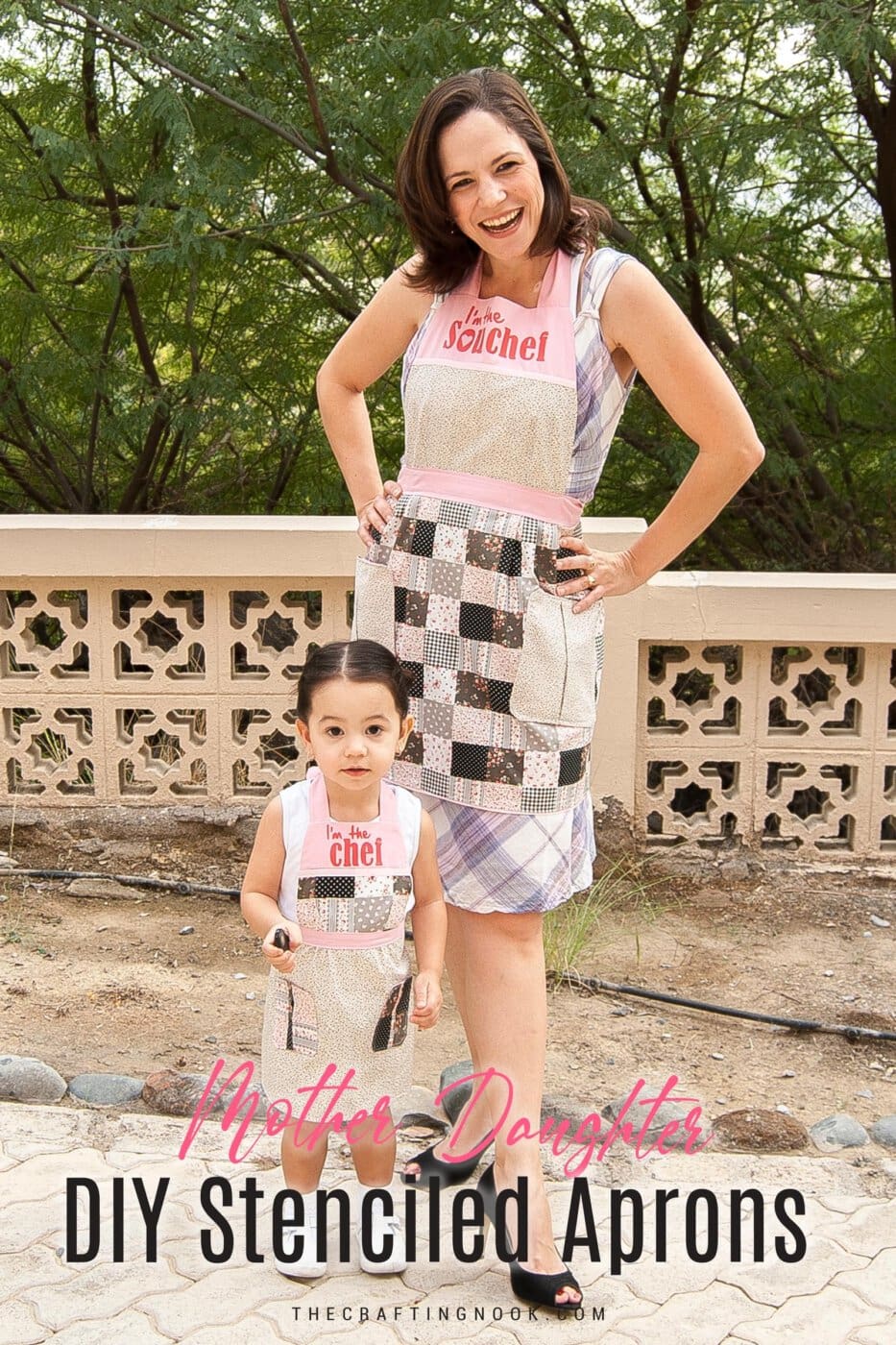The Easiest Homemade DIY Heating Pad Ever
You won’t believe how easy it is to make this homemade DIY Heating Pad and it doesn’t require you to be an expert sewer. Learn how to make it here
Are you as cold as I am? If where you live is as cold is as where I live, this tutorial will help you a lot to stay warm. I made these 2 homemade heat packs as gifts for friends back in Bogotá since it’s cold most of the year there!

Table of Contents
DIY Homemade Heating Pad Tutorial
This is the easiest DIY Homemade Heating Pad you will ever make!!! Either if it’s for yourself or as a gift you will have it done in less than 30 minutes.
This post may contain affiliate links. Please read our Disclosure Policy.
You may have endless ways of doing this project. I found this one the easiest but as you might know, imagination is the limit.
Heating pads are a fantastic way to not only stay warm but to ease neck and back pain, muscle aches, and menstrual cramps. A heating pad is often recommended for heat therapy due to its ability to increase blood flow to painful areas. I used to use heating pads a lot for menstrual cramps.
This made at home heating pad project is something that would make a perfect and thoughtful gift during winter or if your life is mostly cold as well as to relieve sore areas.
You only need fabric, ribbon, and white rice, besides thread, a needle, and a sewing machine. Though, I think this is something you might be able to hand sew as well.
Anyway, have a few scraps of fabric you can make this. Also, the size is what you want it to be.
I just love this and the best part is a couple of minutes in the microwave and you will have quite some time of warmth. I love putting the DIY heating pad on my lap while watching TV or close to my hands while I’m on the computer. It’s just awesome.
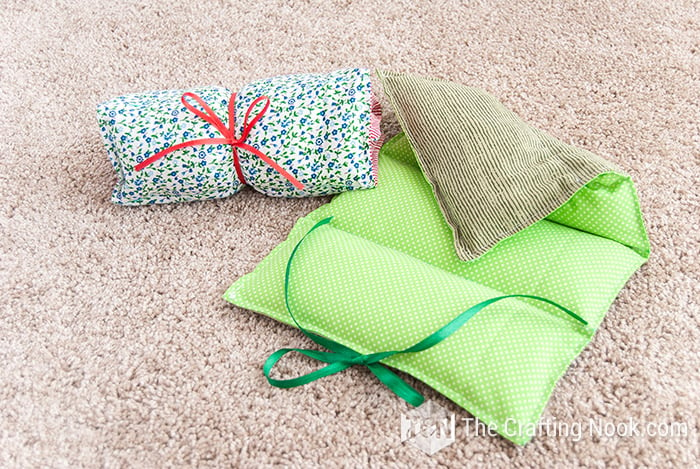
How to Make a DIY Microwavable Heat Pad in Minutes
There are several ways to create your own heating pads, but I’m showing you here how to make large ones to cover more areas weather it’s to stay warm or ease a pain.
Let’s go!
Supplies:
- Cotton fabric – I used scrap pieces I already had, 2 different ones, one for each side. Just make sure it’s 100% cotton, especially if you’ll be heating it in the microwave.
- Uncooked rice – Regular rice works great, but you could also use flaxseed or barley if you prefer.
- Scissors
- Ribbon {fabric matching color}
- Optional: A few drops of essential oil for a calming scent (lavender is my go-to).
Tools:
- Large funnel
- Sewing Machine – Or a needle and thread if you’re sewing by hand.
- Pins or clips – To hold things in place as you sew.
- Scissors
- Fabric (mark-and-be gone) markers.
Rice Variation and Alternatives
Although I have only tested myself, normal rice, jasmine rice, and whole corn, A Little Crispy has tested almost all types of fillings and here is what it shares:
- Best overall options: Whole corn, walnut shells, flax seeds, and jasmine rice are great fillers. I read that cherry pits are great for larger packs, but their heat doesn’t last in a small pack.
- Best scent: Cherry pits, jasmine rice, or walnut shells. If you choose a different filling, you can make it smell really nice by mixing in drops of essential oils, dried flowers, dried herbs, or cherry pits.
- Most pleasant calming feel: Flaxseed, whole corn, jasmine rice.
- Best heat retention: Whole corn, rice, wheat, and walnut shells.
- Worst options: Buckwheat hulls (too expensive), clay beads or cherry pits (poor heat retention in a small pack), dried pinto beans, lentils or whole peas (beany smell), or flaxseed (even after a few heatings the oils were starting to smell a little rancid). Quick note, flax seed would probably make an amazing cold pack if you kept it in the freezer.
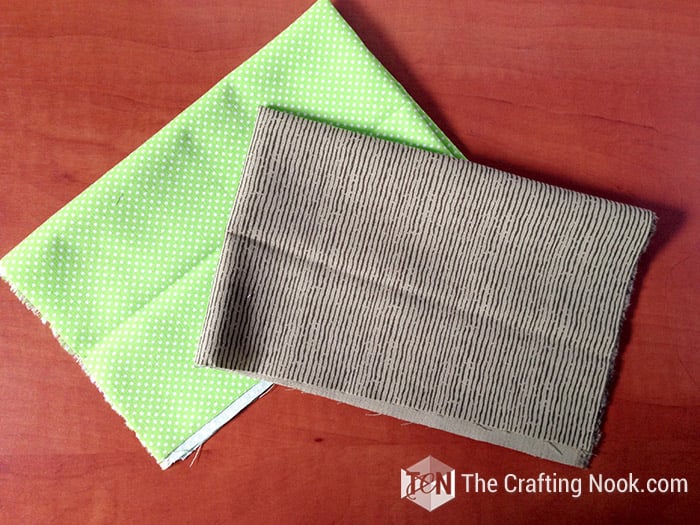
Instructions:
Before we begin, be sure to follow us on Pinterest, Facebook, Instagram, and YouTube, and also sign up for our email list (at the end of this post), so you’ll never miss a post!
This heat pack is one of the easiest projects I’ve ever made. No fancy tools or expensive materials—just a few simple steps and some basic sewing.
Step 1: Cut the fabric
You’ll need two pieces of cotton fabric, both the same size . I usually go with something around 30×15 cm – 12 x 6 inches, but you can adjust the size depending on how big or small you want your heating pad to be.
Just make sure the fabric is 100% cotton, especially if you’re planning to microwave it. Synthetic fabrics can be a fire hazard.
Step 2: Place fabric right sides together
Lay your two pieces of fabric on top of each other with the right sides facing in. That way, when you flip it inside out later, the pretty side will show.
Step 3: Sew around the edges
Leave about a 1 cm (¼ inch) seam allowance on all sides. I also like to draw lines every 7 cm (2.75 inches) across the width to mark where each rice pocket will go later.
(This part is just for reference for now—you’ll see why in a sec.)

Now, cut a piece of ribbon about twice as long as your heating pad width.
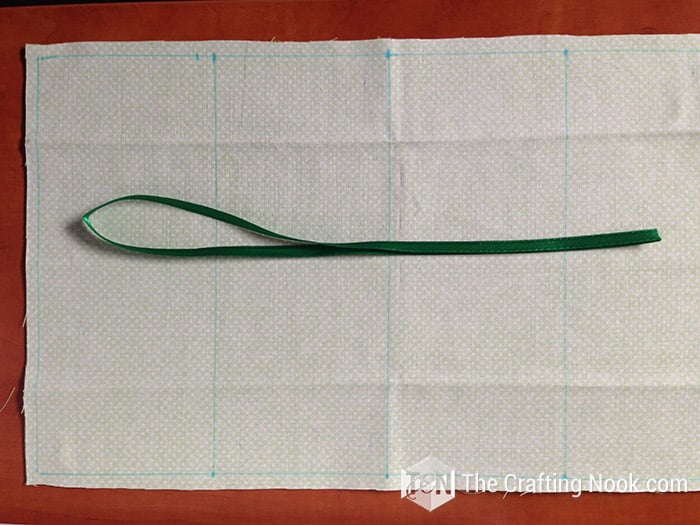
Fold it in half and place it in between the fabric layers, centered along one of the short ends.
Pin it in place. This will be the tie that holds your heating pad when rolled up.

Step 4: Sew the outer edges
Go ahead and stitch around three sides, leaving one of the long sides open.
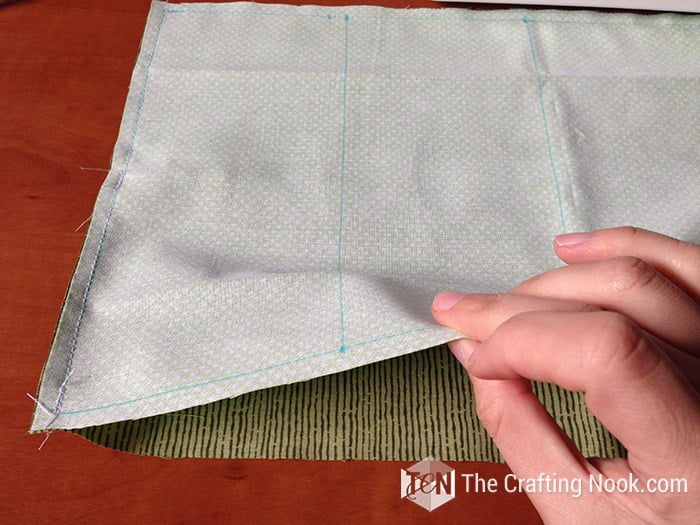
Flip the whole thing right side out and give it a nice press with the iron to flatten everything out.
This is where those reference lines come back in. Since they’re now on the inside, just mark a few dashed lines on top so you can follow them when sewing the pockets later.
Fold in the edges of the open side to create a hem and pin in place. This will make it easier to sew everything up once the rice is added.
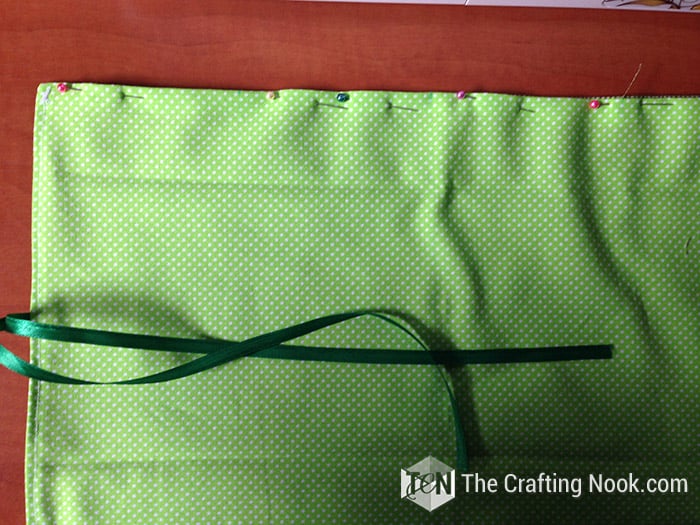
For a neater finish, I like to sew around the edges again (French seam style). Totally optional, but it does look nicer.
Now, go ahead and sew along those marked lines to create the pocket sections. That’s what keeps the rice evenly distributed and makes the heating pad feel so good to use.
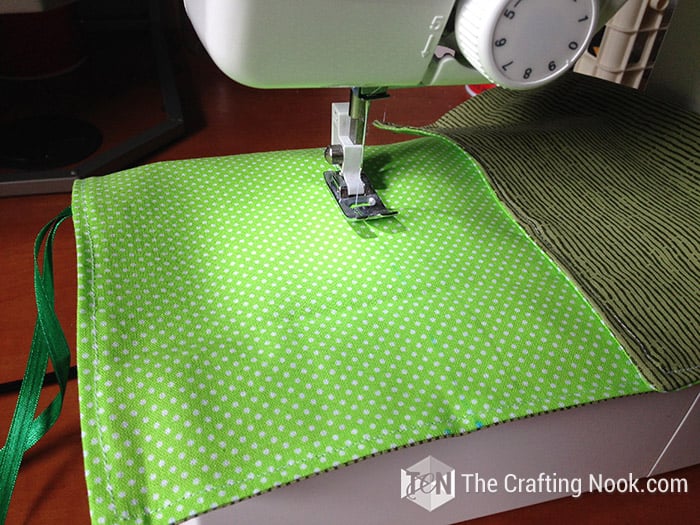
Cut all the remaining threads.
Step 5: Filling up the heat pad
Using a funnel (or a spoon if you’re careful), fill each pocket about ¾ full with rice. You want them full enough to hold warmth, but still soft and bendy.
Optional: Add a drop or two of essential oil to each pocket before filling for a nice calming scent. Lavender is my go-to!
Step 6: Closing It up
As you fill each pocket, press the rice down gently and pin right above it to keep everything in place for stitching (Sorry, I completely forgot to take a picture of this step).
Once they’re all filled and pinned, sew each pocket closed along the top edge.
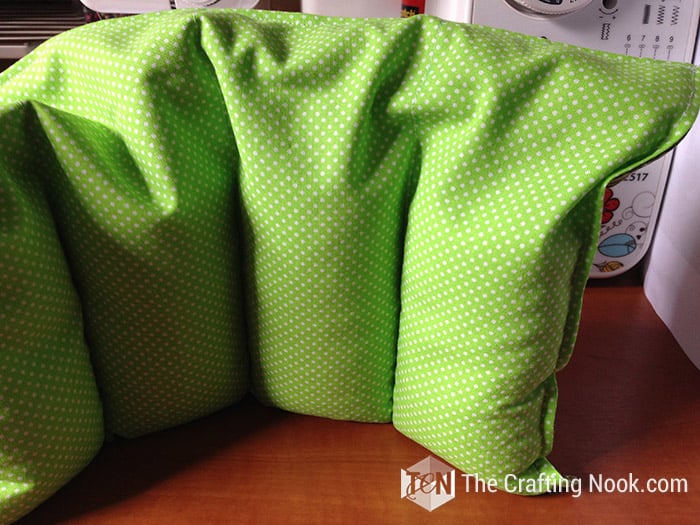
Remove the pins, let the rice settle, and smooth everything out.
Step 7: Finishing touches
Roll your homemade DIY heating pad and tie it up with that ribbon you added earlier. Make a cute bow and that’s it—your cozy, microwavable heating pad is ready to use!
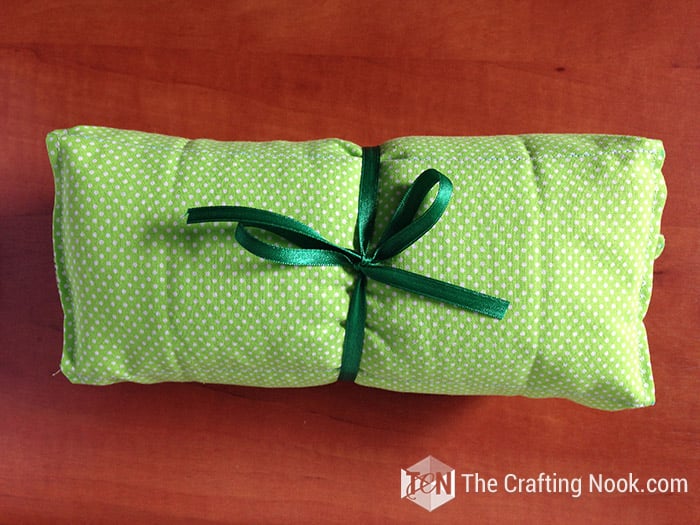
There you go!
I even made some other Homemade Heat packs in different colors!
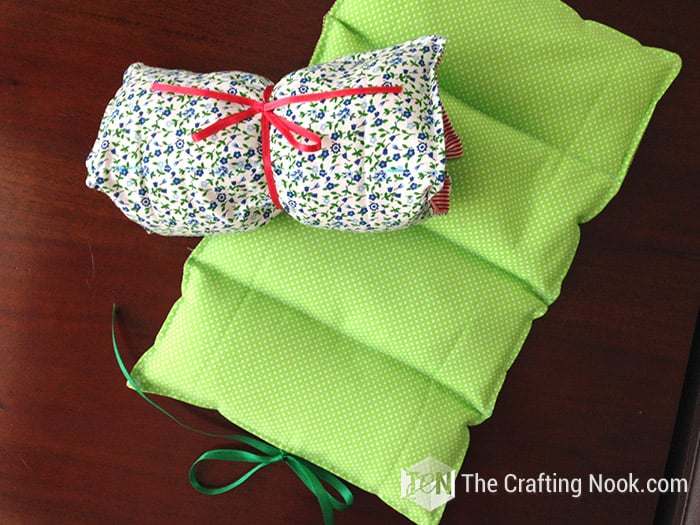
It’s super easy, quick to make and so, so awesome to stay warm.
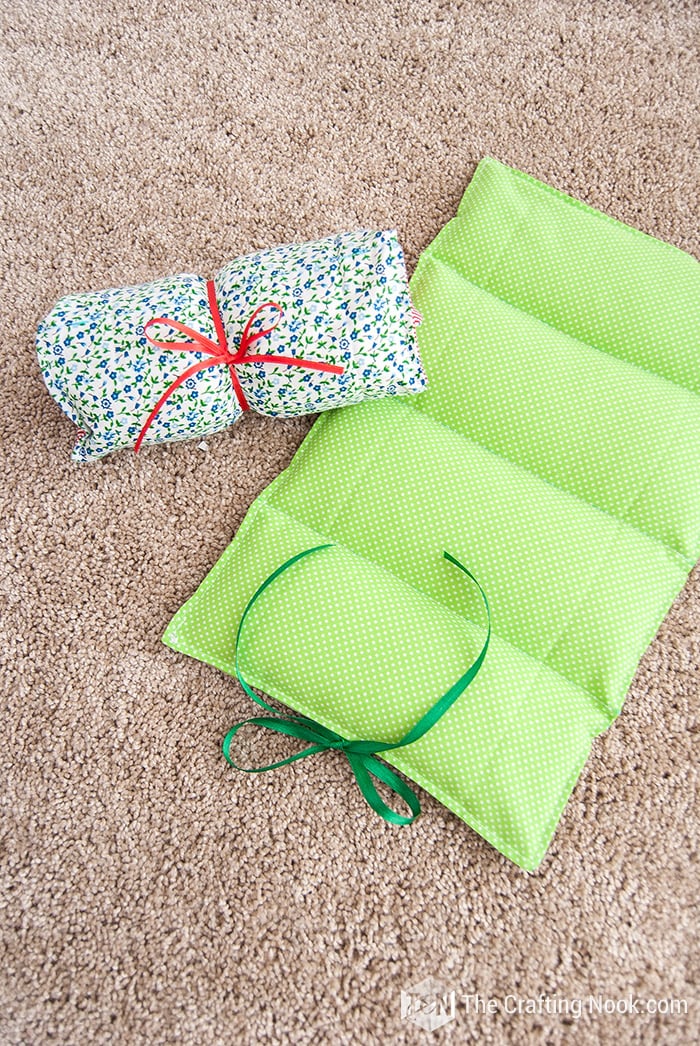
Crafting Tips
- If you want to be able to wash it, sew a simple envelope-style cover using cotton fabric. That way you can toss the cover in the wash while keeping the rice pack clean and dry inside.
- Experiment with combining different fabrics for the front and back of your heat pack. Consider using a soft fleece for one side and a smooth cotton for the other to create different textures.
- You can create a dual-purpose heat pack by adding Velcro strips to the back. This allows it to be attached to a belt or waistband for targeted relief on the go.
- Create your heat packs for different themes or occasions. For example, make heart-shaped ones for Valentine’s Day or pumpkin-shaped ones for Halloween.
- Mix rice with dried herbs – A little dried lavender, rosemary, or mint mixed in with the rice gives it a beautiful, spa-like scent when heated. (Just make sure it’s all dry to avoid any issues in the microwave.)
- Infuse your rice with drops of lavender oil, eucalyptus or your favorite essential oil for added relaxation or sinus relief. Simply add a few drops of your favorite oil to the rice before filling the pockets.
- Make mini versions for hand warmers – Cut your fabric into small squares or rectangles and make mini heat packs to pop in your coat pockets during winter. Great for gifting too!
- Use decorative stitches on your sewing machine to add personality to the seams of your heat pack.
- Add different textures to your heat pack by incorporating materials like ribbons, lace, or faux fur trim along the edges.

Hope you enjoy today’s tutorial and that you got inspired to make your own.
Variations and alternatives
Some homemade heating pad without rice alternatives that can be made at home dependnding on what you are using it for could be:
- Sew a small pocket on the outside to slip in a note, a mini lavender sachet, or even a heating pad liner (if you’re gifting it). It’s a fun touch that makes it feel more personal.
- Neck and shoulder wrap – Make a longer, curved version that rests naturally over the shoulders. You can sew multiple small sections so the rice stays evenly distributed around the curve.
- Square pad or large rectangle – Great for covering your tummy or lower back during cramps or general aches.
- U-shape or eye mask size – Perfect for relaxation or migraines. Add an elastic band to the eye mask version so it stays in place.
- The Oven-Heated Towel: This method is perfect for making a larger heating pad. Fold a damp towel and place it in an oven preheated to 300°F (149°C) for 5-10 minutes (time varies based on towel thickness). Wrap the warm towel in a thinner dry cloth and apply it to the affected area for 15-20 minutes.
- The Rice Old Sock: Take an old, clean sock and fill it three-quarters full with uncooked rice, corn, barley, or oatmeal. Tie or sew it shut and heat it in the microwave for 1-2 minutes. Always test the heat on the inside of your arm before applying it to ensure it’s comfortably warm, not hot.
Safety Tips
While heating pads are generally safe, there are a few precautions to keep in mind:
- Avoid using the diy hot pack way too hot directly on the skin. To pre-heat the bed is very useful when it’s really hot though.
- Avoid using heating pads immediately after an injury as heat can increase swelling.
- Any heating pad use while pregnant should avoid. Applying heating pads to the abdomen or pelvic area is not recommended and also should steer clear of hot tubs and very hot showers.
Frequently Asked Questions
A heat pack or heating pad is a microwavable grain-filled bag that is widely used to provide relief for general muscular aches and pains and to bring heat in cold weather. They consist of a fabric outer cover with a grain filling which is usually rice, wheat, barley, or lupin.
A heat pack is great to keep yourself warm which is a great benefit but the original purpose of a heating pad is to relieve pain. It could help increase blood flow and decrease pain for muscular injury. It can also be used for relaxation, menstrual cramps, back pain, sore muscles, and so much more.
Just keep in mind that a homemade rice heating pad is not a substitute for real treatment or your doctor’s diagnosis.
Best overall options: Whole corn, walnut shells, jasmine rice. I read that cherry pits are great for larger packs, but their heat doesn’t last in a small pack.
Best scent: Cherry pits, jasmine rice, or walnut shells. If you choose a different filling, you can make it smell really nice by mixing in drops of essential oils, dried flowers, dried herbs, or cherry pits.
Most pleasant calming feel: Flaxseed, whole corn, jasmine rice.
Best heat retention: Whole corn, rice, wheat, walnut shells.
Worst options: Buckwheat hulls (too expensive), clay beads or cherry pits (poor heat retention in a small pack), dried pinto beans or whole peas (beany smell), or flaxseed (even after a few heating’s the oils were starting to smell a little rancid).
Quick note, flaxseed would probably make an amazing cold pack if you kept it in the freezer.
According to Medical News Today, Women who are pregnant should not apply heating pads to the abdomen or pelvic area. They should also avoid hot tubs and bathing or showering in very hot water.
More Sewing Projects to Try
If you enjoyed this fun DIY Heating Pad tutorial, you might also love these other cute sewing project ideas too:
✂️ Tutorial

Homemade DIY Heat Pack Tutorial
Tools
- Sewing Machine
Supplies
- Your favorite fabrics. I used 2 different ones one for each side.
- Ribbon {fabric matching color}
- Regular rice
- Large funnel
- scissors
- fabric mark-and-be gone markers.
- Essential oils *optionl.
Instructions
STEP 1: CUT THE FABRIC
- First, cut your fabric to the desired size. Mine was 30×15 cm {12X6 Inches}. It’s a large homemade heating pad.
STEP 2: CREATING THE HEAT PACK MAIN BAG
- Then putting together the front and back pieces right sides together, trace your layout.
- I left 1cm (1/4 inch) seam allowance from the edge on each side and traced lines every 7 cm (2.75 inches). This will make the rice pockets.
- Or course this will be only for reference you will see why in a bit.
- Cut a string of ribbon about double the length of your heat pack.
- Fold in half.
- view of string of ribbon on open fabric marked with measurements
- Place it in between both fabrics lengthwise about in the middle of one of the short sides.
- Pin in place.
STEP 3: SEWING THE PACK
- Stitch along the sides leaving one long side open.
- Turn it right side out. Press.
- This is where I was talking about the reference.
- Your lines are now inside but you can make a few dashes so you know where to stitch.
- Fold your open side edges inwards to make a hem. Pin in place.
- I do this because it’s easier to fill each pocket and then stitch them close later.
- Stitch around the edges again (french seam) to make it look prettier.
- Stitch each pocket’s lines.
- Cut all the remaining threads.
STEP 4: FILLING UP THE HEAT PACK
- Using a large funnel fill 3/4 of each pocket with white or jasmine rice.
- Optionally you can add a few drops of essential oils in each pocket
STEP 5: CLOSING UP THE HEATING PAD
- Using a pin, Close each pocket really close to the top of the rice. Sorry I completely forgot to take a picture of this step. But once you have filled a pocket just press all the rice down press closing the pocket right where the rice is and pin. This is only to make it easy to stitch close the heat pack.
- When you are done filling the pockets and pinning each one, just stitch along the edge.
- Remove the pins and let the rice spread.
STEP 6: FINISHING UP THE CUTE HEAT PACK
- Roll the heat pack and tie it with your ribbon and make a cute bow.
- There you go! You are done! You can make more in different colors.
Some other heat packs I love from my favorite bloggers:
- Diy No-Sew Natural Heating Pads (Rice Socks) by Making Lemonade.
- DIY Rice Heating Pad with Lavender essential oils by Crafting in the Rain
If you enjoyed this DIY Homemade Heat Pack tutorial, don’t forget to PIN and share it with friends!

Til’ next time…

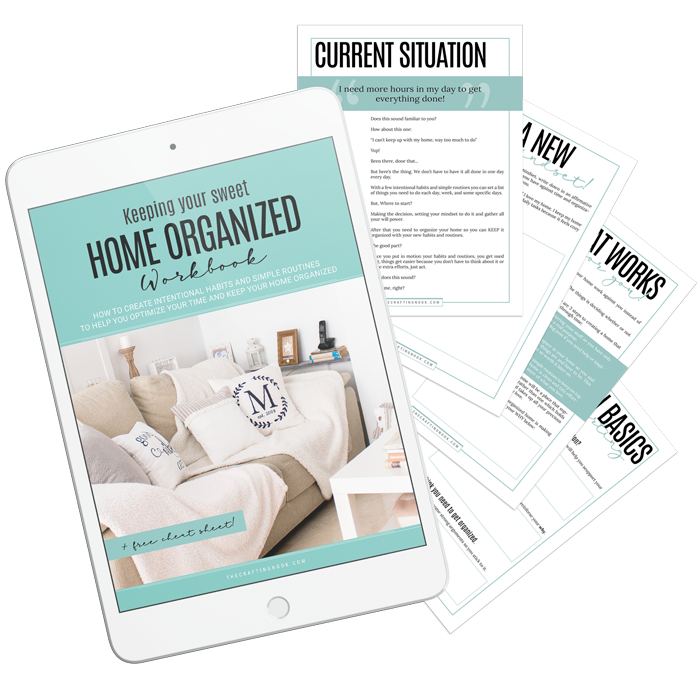
FREE WORKBOOK
Keeping your Sweet Home Organized
Learn how to create intentional habits and simple routines to Keep Your Home Organized. Plus freebies, printables, exclusive content, and tips.
Disclaimer: By clicking on the “Yes” button above you are giving me your consent to collect and use your information according to the law and My Policy Privacy. Zero Spam I promise!


